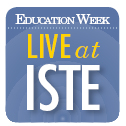ISTE to Charge Businesses for Licensing of Standards, and Announces Microsoft Partnership
Denver
Leaders of the International Society for Technology in Education are launching the organization’s first-ever effort to raise revenue through licensing fees tied to companies’ use of the organization’s digital standards, the group’s chief executive officer said Sunday.
The organization, which kicked off its huge annual conference here yesterday, will charge the fees to commercial companies, consultants, and others developing products based on the standards, which are meant to guide the process of teaching and learning through technology, ISTE CEO Brian Lewis said in an interview.
The goal of the change is to diversify ISTE’s revenue sources and make the organization less reliant on its conference, Lewis said. The organization’s overall annual budget stands at roughly $16 million, he estimated.
A few years ago, the conference accounted for 52 percent of the nonprofit organization’s gross revenue, he said. It now accounts for 60 percent, with corporate sponsorships and memberships also contributing to the organization.
“In all these years, ISTE has never generated any revenue out of its IP [intellectual property] it put out in the world,” explained Lewis, who said he has worked with the organization’s board on the licensing strategy.
Educators will continue to have access to the technology standards for free. But “if you’re a business, and you’re developing a product or service or doing consulting based on the standards, you’re going to have to license them, and pay this nonprofit for their use,” Lewis said.
“We’ve got to operate in a way that makes sense, and in a way that generates longevity, by protecting intellectual property,” he added.
Lewis spoke of the licensing strategy on the same day ISTE announced an unrelated partnership with Microsoft. The agreement is meant to greatly expand and improve professional development for teachers and administrator with technology in the United States and around the world.
A key piece of that partnership is to expand PD from teachers to leaders–especially school administrators, policymakers and others who can advocate for the effective use of technology in schools and improve the scale of those efforts.
“We’ve seen teachers driving the pace of change, within their individual classrooms,” said Anthony Salcito, vice president of worldwide education for Microsoft, in an interview.
But doing more to reduce the “digital divide” in students’ opportunities to use technology “requires leadership,” he added. “We see a huge need in supporting leaders. We’ve done a lot of work in professional development for teachers. But the real shift is how to we get leaders ready for this world.”
Microsoft has “looked for partners” in that effort, Salcito said, and ISTE is an important one.
ISTE and Microsoft will also work together to develop new Microsoft Showcase Schools, a group of more than 600 schools worldwide that are attempting to transform teaching and learning through technology. The partnership will bring more support for the schools, and their use of the ISTE technology standards, the two organizations said in statement.
“If we’re going to have the kind of impact we want to have, we’re going to need to collaborate with and partner with others with whom we have a common mission and commitment,” Lewis said. That work has to occur “faster, sooner, and more effectively, with more students,” he added.
Lewis said he wants other organizations to join ISTE and Microsoft in their work.
